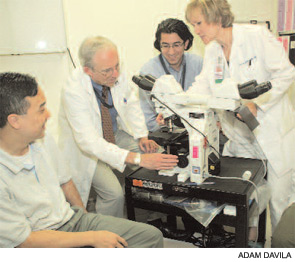
I was a staff physician-rheumatologist at the Mayo Clinic in Rochester, Minn., for 25 years. For the last nine years I’ve been physician-rheumatologist at Emory University School of Medicine in Atlanta, primarily at Grady Hospital. Mayo is a mecca for rheumatology, while Grady is a prototypic public hospital. The experiences at these institutions have been vastly different, yet one has allowed me to succeed in the other.
Path from Plenty to Paucity
I took my medicine residency and rheumatology fellowship at Mayo, then I joined the staff where I spent the next 25 years practicing rheumatology in an efficient, integrated medical care system. It was easy to deliver high-quality care in that environment. The system was designed to be efficient, stimulating, and interactive for the physicians and surgeons on the staff. I also had the opportunity to teach, conduct clinical investigation, and contribute to the literature—primarily in the area of vasculitis—and I was involved in administration.
I came to Atlanta to be medical director of the National Arthritis Foundation, but got involved at Emory right away, helping staff the arthritis clinic at Grady on Mondays. After three years at the Arthritis Foundation, I went to Grady full time, and the following year I became director of rheumatology at Emory. Between 1999 and 2007, I build the fellowship program, expand the staff, and got clinical investigation started.
Rheumatology at Grady
I want to focus on the rheumatology patient population at Grady, and the challenges and opportunities there. The majority of the patients are African Americans—usually with no insurance or on Medicaid. Many have no jobs or are part of the working poor. We see a spectrum of rheumatic diseases and have large numbers of patients with osteoarthritis (primarily of the knees), rheumatoid arthritis, lupus, and gout.
What are the challenges in seeing patients at Grady? We have paper charts, but cannot easily retrieve charts from other clinics, such as orthopedics, neurology, and dermatology. It is impossible to get timely consultation. We can get routine labs and X-rays performed and results back in good time, but for examinations like CT or MRI, it may take a month to get the test done.
On Mondays the Grady arthritis clinic is the continuity clinic for our six rheumatology subspecialty residents. We also have two or three internal medicine residents on Monday. In our other clinics we have one subspecialty resident and several medicine residents. Our challenge is to provide the best care possible and, at the same time, make this a good educational experience.

I could not have met this challenge earlier in my career in this setting with this patient population. Earlier, I did not have the knowledge, the patience, and— particularly—the experience or confidence. After more than 35 years in rheumatology, I have seen most of diseases and conditions that present to us. At Mayo, I had the benefit of an efficient system, with all tests at my fingertips and consultations readily available, and I learned what is needed to evaluate patients in most circumstances and when a consultation is helpful.